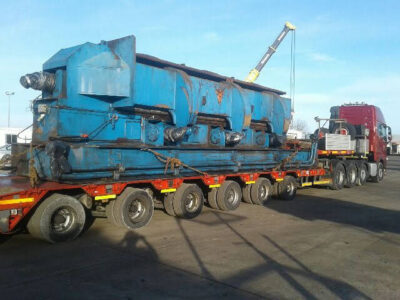Machine relocations
Relocation of construction and recycling machines.
Relocating construction and recycling machinery is a complex and demanding process that requires special attention and planning. On the one hand, we are dealing with huge, heavy and often delicate devices, and on the other - with the need to ensure their safety and effectiveness after relocation. In this article, we will discuss the key aspects of moving this type of machinery, starting from planning, through execution, to reinstallation and commissioning.
Relocation Planning
- Analysis and Assessment
The first step is a thorough analysis of the machines to be moved. It is important to understand their dimensions, weight, transportation requirements and any technical specifications. For recycling machines, which often contain complex systems, it is also important to know their functions and how they work. - Selection of Transport Methods and Tools
Based on the acquired knowledge, appropriate transport methods and tools should be selected. Specialized vehicles, such as low-bed trailers, as well as cranes and other lifting equipment are often used to move heavy machinery. - Logistics and Coordination
A key element is planning logistics: setting a route, setting a schedule and coordinating with the teams involved in the process. It is important to take into account potential obstacles such as road infrastructure restrictions and legal requirements for transporting heavy equipment.
Execution of Relocation
- Dismantling Machines
Many machines require disassembly into smaller parts so that they can be safely transported. This process must be performed by experienced technicians who know the machine well. - Safe Transport
Securing machines during transport is crucial. They must be properly secured and secured to prevent damage during transport. - Monitoring and Control
During transport, continuous control and monitoring is important, which allows for quick reaction in the event of unforeseen events.
Reinstallation and Restart
- Assembly and Calibration
Once on site, the machines must be reassembled and calibrated. This stage is as important as disassembly, because the correct operation of the device after relocation depends on it. - Testing and Commissioning
Before being put back into service, machines should be subjected to a series of tests to ensure everything is working properly. Only after successfully passing these tests can the machine be restarted. - Staff Training
If machines have been moved to a new location where they will be operated by different staff, training on their use may be necessary.
Relocating construction and recycling machinery is a task that requires detailed planning and coordination. It requires not only appropriate physical resources, but also technical knowledge and experience. The key to success here is cooperation with professional companies that specialize in this type of activities. When carried out in accordance with best practices, relocation can be carried out smoothly and efficiently, minimizing the risk of damage and downtime.

